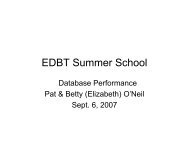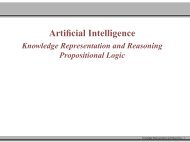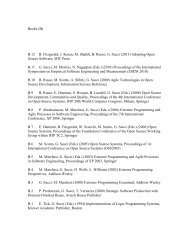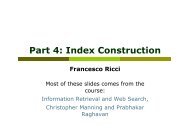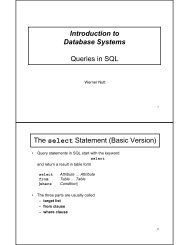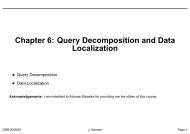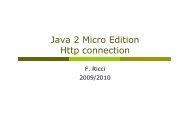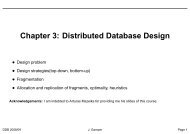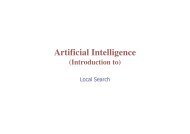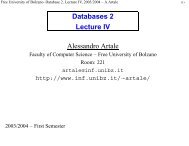Prototype testing for a destination recommender system: steps ...
Prototype testing for a destination recommender system: steps ...
Prototype testing for a destination recommender system: steps ...
Create successful ePaper yourself
Turn your PDF publications into a flip-book with our unique Google optimized e-Paper software.
<strong>Prototype</strong> Testing <strong>for</strong> a Destination Recommender<br />
System: Steps, Procedures and Implications<br />
Andreas H. Zins a ,<br />
Ulrike Bauernfeind a ,<br />
Fabio Del Missier b ,<br />
Nicole Mitsche a ,<br />
Francesco Ricci b<br />
Hildegard Rumetshofer c , and<br />
Erwin Schaumlechner d<br />
a Institute <strong>for</strong> Tourism and Leisure Studies<br />
Vienna University of Economics and Business Administration, Austria<br />
{zins, bauernfeind, mitsche}@wu-wien.ac.at<br />
b ITC-irst<br />
Electronic Commerce and Tourism Research Laboratory, Italy<br />
{delmissier, ricci}@itc.it<br />
c Institute <strong>for</strong> Applied Knowledge Processing<br />
University of Linz, Austria<br />
hildegard.rumetshofer@faw.uni-linz.ac.at<br />
d Tiscover, Austria<br />
erwin.schaumlechner@TIScover.com<br />
Abstract<br />
This paper describes and discusses the application of various state-of-the-art techniques to<br />
improve the design and usability of a web application in the B2C area. It is illustrated by the<br />
ongoing project of developing an intelligent <strong>destination</strong> <strong>recommender</strong> <strong>system</strong> (DieToRecs).<br />
These techniques comprise four particular evaluation <strong>steps</strong>: 1. a concept test, 2. a cognitive<br />
walkthrough, 3. a heuristic evaluation, and 4. an experimental evaluation by <strong>system</strong> users. Each<br />
section (i.e. evaluation step) addresses three areas of interest: a) the starting situation and<br />
objective, b) a short description of the applied method and the procedure, c) a brief summary of<br />
the results and the lessons learned <strong>for</strong> the general use of evaluative techniques.<br />
Keywords: <strong>recommender</strong> <strong>system</strong>, usability, prototype <strong>testing</strong>, <strong>system</strong> evaluation<br />
1 Introduction<br />
At present the DieToRecs <strong>system</strong> is in the stage of a first prototype. Its development<br />
includes a number of characteristics distinguishing it from already existing<br />
<strong>recommender</strong> <strong>system</strong>s (Fesenmaier et al. 2003). First, DieToRecs is a <strong>destination</strong><br />
advisory <strong>system</strong> based on CBR (case based reasoning). CBR is a methodology trying
to solve a problem by retrieving and using a similar, already solved case. A case is<br />
defined as any single user-<strong>system</strong> interaction history and consists of travel wishes and<br />
constraints, the travel plan (a bundle of items being interesting <strong>for</strong> the user and which<br />
is there<strong>for</strong>e collected), the user profile, and finally the outcome of one or more travel<br />
plans. Second, a collaborative filtering <strong>system</strong>, based on similarity of sessions rather<br />
than the classical correlation of votes, is employed enabling to reuse travel plans built<br />
by similar users. Finally, the <strong>system</strong> is a conversational tool meaning that the user<br />
should feel like interacting with a human being. Queries and suggestions follow<br />
successively to enable a vivid question and answer process. Interactive query<br />
management is employed to handle queries more efficiently. The <strong>system</strong> helps the<br />
user to redefine queries: they are relaxed or tightened in order to display a desired<br />
number of ranked results.<br />
Following the concept of a user-centred usability engineering (Manhartsberger &<br />
Musil 2002) the <strong>system</strong> development was subdivided into four phases:<br />
• Development of the decision model: collection of use cases and <strong>system</strong> features,<br />
development of a realistic model of the user decision process, including the<br />
modelling of <strong>destination</strong>.<br />
• First prototype design and development: the key technologies and the decision<br />
model provide input <strong>for</strong> the design and the development of the first prototype, a<br />
fully operational <strong>recommender</strong> <strong>system</strong> with key components such as dialogue<br />
management based on the tourist decision model, similarity based queries,<br />
filtering using a user model, and user activity logging.<br />
• <strong>Prototype</strong> management and evaluation: experimental tests determine the<br />
statistical and practical significance of the improvements brought by each single<br />
technique.<br />
• Final recommendation <strong>system</strong> and framework: at this stage, log data collected<br />
with the first prototype will be used <strong>for</strong> user profile learning and <strong>for</strong> tuning the<br />
various filtering techniques implemented.
Use Cases<br />
according System<br />
Requirements<br />
Analyse,<br />
Evaluate,<br />
Revise<br />
1. GUI Mock-up<br />
Consortium Evalution<br />
2. GUI Mock-up<br />
Concept Test,<br />
Cognitive Styles<br />
3. GUI Mock-up<br />
Review Meeting,<br />
First Expert Evaluation<br />
4. <strong>Prototype</strong> V0.5<br />
Second Expert Evaluation<br />
5. <strong>Prototype</strong> V0.8<br />
Pre-Test of the<br />
First <strong>Prototype</strong><br />
6. <strong>Prototype</strong> V1.0<br />
First <strong>Prototype</strong> Evaluation<br />
Fig. 1. Re-engineering process to build the GUI in DIETORECS<br />
In order to achieve a really superior <strong>recommender</strong> <strong>system</strong> the software quality had to<br />
be reviewed and evaluated at the various developmental stages. With regard to quality<br />
standards we refer to the views of product quality in terms of the appropriate ISO/IEC<br />
norms and definitions (ISO/IEC 9261, FCS 9216-1, ISO 9241-11). These go beyond<br />
the ergonomic concept of usability and are aimed at improving the effectiveness,<br />
productivity and satisfaction a user perceives in a specific working environment<br />
(Bevan 1999). To cover a maximum of perspectives a series of <strong>steps</strong> of <strong>for</strong>mative<br />
evaluation have been taken so far in addition to the continuous checks and adaptations<br />
undertaken by the developers of the DieToRecs <strong>system</strong>.<br />
Figure 1 sketches the stages in the development process combined with evaluative<br />
milestones carried out to adjust the <strong>system</strong> functionality and usability to the<br />
requirements determined during the initial use case phase. The following sections of<br />
this paper present and discuss the evaluation <strong>steps</strong> 2, 3, 4, and 6: 1. a general concept<br />
test challenging two different interface options, 2. a cognitive walkthrough, 3. a<br />
heuristic evaluation, and 4. an experimental evaluation by <strong>system</strong> users. Each section<br />
(i.e. evaluation step) addresses three areas of interest: a) the starting situation and<br />
objective, b) a short description of the applied method and the procedure, c) a brief<br />
summary of the results and the lessons learned <strong>for</strong> the general use of evaluative<br />
techniques.
2 Concept test with a horizontal prototype<br />
From literature review and an additional observational study the user model <strong>for</strong> the<br />
<strong>destination</strong> recommendation <strong>system</strong> was elaborated. One of the basic premises was<br />
that the <strong>system</strong> has to serve users with different decision styles (Grabler & Zins<br />
2002). There<strong>for</strong>e, a concept test (Dalgleish 2000) had been conducted in an early<br />
stage of the prototype development (Pearrow 2000). The purpose was to investigate<br />
the potential advantages of two effects of the human-computer interaction: 1. giving<br />
the user the choice to select among two alternative navigational options A (more<br />
sequential) and B (more pictorial-holistic), and 2. classifying the user in advance into<br />
one of two broad categories of cognitive styles (A’: analytical and B’: holistic) to<br />
direct her/him to the potentially more suitable navigational option. For the empirical<br />
test a horizontal prototype (Nielsen 1993; Rudd & Isensee 1994) or so-called<br />
demonstrator (i.e. a not yet fully operable <strong>system</strong> of related web pages to collect or<br />
identify the user’s travel preferences and wishes) had been developed and presented<br />
to 176 test persons (internet users only). As the graphical user-interface was already<br />
in an advanced stage and responded to a limited set of keyboard and mouse inputs it<br />
can be seen as a high-fidelity prototype (Walker et al. 2002).<br />
Results have been encouraging and in favour of offering two alternative <strong>system</strong><br />
accesses: a classical interface with check boxes and structured input fields and<br />
another more holistic approach using sketches of already existing travel bundles <strong>for</strong><br />
revealing someone’s travel preferences and constraints. The analysis highlighted that<br />
users should be classified in advance to one of the corresponding cognitive styles.<br />
This is based on the observations that asking them in advance and let them choose<br />
anyway between two interface options leads to a substantial rate of a misleading selfselection.<br />
The probable consequences are a reduced user satisfaction and in the worst<br />
case a lost costumer.<br />
For the further DieToRecs development it was decided to follow the encouraging<br />
direction of creating two different entrance gates: one <strong>for</strong> the more analytical,<br />
decompositional process of communicating someone’s travel preferences and<br />
contingencies and another supporting a more holistic approach based on fuzzy cues<br />
and responses from which the user gets some inspiration <strong>for</strong> the concrete travel<br />
planning task. Still unresolved problems and areas are: 1. finding and applying well<br />
per<strong>for</strong>ming and not boring a priori classification instruments to detect the user’s<br />
appropriate cognitive style, 2. <strong>testing</strong> multiple interface alternatives to better address<br />
the inhomogeneous audience 3. comparing the per<strong>for</strong>mance and user evaluation of<br />
competing fully functional <strong>recommender</strong> <strong>system</strong>s with alternative presentation and<br />
interaction designs as proposed by Rumetshofer et al. (2003).<br />
3 Cognitive walkthrough and first heuristic inspection<br />
A completely different kind of evaluation (scenario evaluation) was applied to a GUI<br />
mock-up (without functionalities) developed to allow an early qualitative assessment
of some user interface design choices (Nielsen 1993). The primary goal of this<br />
inspection was to detect substantial weaknesses of the user interface design. A single<br />
expert employed two techniques: cognitive walkthrough and heuristic evaluation. The<br />
<strong>for</strong>mer is a technique <strong>for</strong> evaluating the design of a user interface, with special<br />
attention to how well the interface supports "exploratory learning," i.e., first-time use<br />
without <strong>for</strong>mal training (Rieman et al. 1995). According to Ivory and Hearst (2001)<br />
the expert has to simulate the user’s problem solving. The latter is a technique to<br />
identify violations of heuristics (Ivory and Hearst 2001) proposed by Nielsen (1993)<br />
<strong>for</strong> a quick analysis of applications. The usability guidelines applied <strong>for</strong> this<br />
evaluation have been taken from Nielsen (2001) which have been adapted to define<br />
the following principles: (P1) know your user, (P2) reduce the cognitive work, (P3)<br />
design <strong>for</strong> errors, and (P4) keep the consistency (internal with your <strong>system</strong>s, P4int,<br />
and with respect to common practices P4ext, external).<br />
Important improvements have been achieved following the focal critical comments on<br />
consistent labelling, navigational and menu aspects as well as design considerations.<br />
Changes resulting from the inspection were a rearrangement of the menus (new<br />
design, change of grouping, visualisation through icons, renaming to be consistent).<br />
The start page of the main area was unified with the menus and the registration<br />
process was simplified and better explained to the user. Resolution problems<br />
concerning the display of the interface were solved. Furthermore, a clearer<br />
presentation of the recommendation results was implemented and some<br />
inconsistencies in the use of terminology were eliminated.<br />
Although the re-engineering process of the cognitive walkthrough is pretty tedious to<br />
per<strong>for</strong>m, inconsistencies, and general and recurring problems could be missed, the<br />
method is appropriate in an early prototypical stage. In particular, it is possible to<br />
detect substantial weaknesses be<strong>for</strong>e a prototype is built. A general problem occurring<br />
with cognitive walkthrough and heuristic evaluation is the difficult position of the<br />
evaluator. He has to act as a user with the opinion of an expert, which leads to<br />
ambiguous roles.<br />
4 Heuristic and standardized evaluation by experts<br />
After the adjustments made based on the first inspection, a heuristic evaluation was<br />
carried out on the <strong>Prototype</strong> V0.5 (with functionalities). A major evaluation goal was<br />
to eliminate the major interface and interaction shortcomings prior to the experimental<br />
test. This step seemed to be necessary given the prototypical stage of the <strong>system</strong>.<br />
Lindgaard (1994) defines the heuristic evaluation as a detailed in<strong>for</strong>mal subjective<br />
usability analysis conducted by experts simulating the perspective of a typical end<br />
user. The evaluators do not follow a specific set of methods, rules or procedures;<br />
instead they rely on a set of vague guidelines. The subjective judgements of the<br />
experts are influenced by their experience and background. In addition to the<br />
cognitive walkthrough, the heuristic evaluation is an in-depth analysis collecting all<br />
occurred problems, from the highly serious to the most trivial. Due to the subjective
judgements and the missing structure of the heuristic evaluation, a standardized<br />
instrument was additionally employed to enable comparisons between the judges and<br />
to locate the actual development stage. The comparable evaluation was carried out<br />
using the Purdue Usability Testing Questionnaire (PUTQ). The questionnaire is<br />
composed of 100 questions on <strong>system</strong> interface structured by eight factors that are<br />
relevant to human-computer interaction. These factors were compatibility,<br />
consistency, flexibility, learnability, minimal action, minimal memory load,<br />
perceptual limitation, and user guidance. An essential advantage is the possibility to<br />
compute an index based on the ratings and put into relation to the possible perfect<br />
score (Lin, Choong & Salvendy 1997). The heuristic evaluation was carried out using<br />
five experienced interface judges (according to e.g. Lindgaard 1994, Galitz 2002).<br />
These evaluators had to:<br />
• provide comparative judgements, rating the <strong>system</strong> on a variety of dimensions by<br />
the PUTQ;<br />
• per<strong>for</strong>m a detailed analysis of the general <strong>system</strong> functionality, of the interface,<br />
and of the user-<strong>system</strong> interaction aspects.<br />
The heuristic evaluation results, quite a long list of modifications, were summarized<br />
in groups (start page, navigation, layout and design, travel planning process,<br />
recommendation process, and results) and sorted by their importance. The most<br />
critical issues were solved be<strong>for</strong>e the experimental user evaluation took place. A lot of<br />
changes were made. However, a few examples of detailed problems will serve <strong>for</strong><br />
better illustration:<br />
•<br />
•<br />
•<br />
the page expired too early and the pages loaded too slow<br />
budget range (to indicate possible travel expenses) was too small<br />
inconsistent use of the term “travel plan” (“travel bag” was used as well and<br />
created confusion).<br />
Overall, the experts gave the <strong>system</strong> a good quality total grade (PUTQ Index: 65.0 –<br />
the higher the score, the better the usability result; scale of 100), especially with<br />
respect to perceptual limitations, compatibility and learnability. Deficiencies were<br />
identified in user guidance and flexibility which mainly results from functions not<br />
available due to the prototypical status. As implication s from the heuristic evaluation<br />
additional work should be invested in typical prototype troubles such as further<br />
extension of the database, help function and error messages. The recommendation<br />
process is one of the major focuses of further developments. In particular, as seen<br />
from the detailed heuristic evaluation and the PUTQ questionnaire, more ef<strong>for</strong>t has to<br />
be set into the development of wording and explanations to aid the user through the<br />
recommendation process. Another focus should be given on the presentation of the<br />
result pages when the user accesses an item detailed site, asks <strong>for</strong> more<br />
recommendations, browses her current travel plan, and enters into the “Searching <strong>for</strong><br />
inspiration” gate (the holistic interface that allows the user to navigate the travel<br />
offers exploiting visual clues, see Figure 2).<br />
The heuristic evaluation was an important step during the re-engineering process of<br />
the first prototype. The success and richness of the observations suggests another
detailed expert evaluation during the final evaluation of the second prototype. As far<br />
as the PUTQ as standardized questionnaire is concerned it turned out to be a quite<br />
valuable tool allowing comparisons because of the standardization. On the other hand,<br />
the questionnaire is tailored to general computer interfaces and there<strong>for</strong>e, some<br />
application problems on web-based <strong>system</strong>s arose. Furthermore, some web specific<br />
problem areas remain unconsidered. It is suggested to adapt the PUTQ Questionnaire,<br />
considering research about web usability indices (e.g. Keevil 1998, Harms et al.<br />
2000), without giving up the comprehensiveness of the PUTQ.<br />
5 Experimental evaluation by potential users<br />
This – so far – final step of evaluating the re-engineering process of the first prototype<br />
was conceived to involve the end user of such a <strong>destination</strong> <strong>recommender</strong> <strong>system</strong>. Its<br />
major focus was on the innovative contributions that DieToRecs is supposed to<br />
generate which are essentially the recommendation functions. Hence, the main ef<strong>for</strong>t<br />
of this evaluation was indeed dedicated to the implementation of the recommendation<br />
functions which are supposed to be general enough to be integrated into a variety of<br />
specific applications (web sites). The <strong>system</strong> prototype (V1.0; see Figure 1) is a tool<br />
that allowed <strong>testing</strong> of these general functions in a more controlled yet flexible way;<br />
i.e. without having to cope with the engineering problems regarding the real<br />
integration of the recommendation components into an existing application.<br />
Fig. 2 Screenshots <strong>for</strong> a Feature-based Search Result and <strong>for</strong> “Seeking <strong>for</strong> Inspiration”
The approach of this experimental evaluation consisted of building a limited set of<br />
variants of the DieToRecs prototype to test hypotheses about the per<strong>for</strong>mance of the<br />
<strong>system</strong> on a set of dependent measures. The main hypotheses concerned the users’<br />
search and choice behaviour, and their satisfaction. They are stated as follows: The<br />
query management, the case-based ranking functions, and the other recommendation<br />
functions embedded into the DieToRecs <strong>system</strong> are able to:<br />
• provide valuable recommendations <strong>for</strong> the user;<br />
• help the user to construct better plans;<br />
• enhance the efficiency of the interactive search and decision making processes<br />
involved in the plan construction;<br />
• increase user satisfaction.<br />
Three variants were to be tested:<br />
• DTR-A: interactive query management only, i.e., supporting the user in case of<br />
query failures (too many or no result) but not using a case base of previously<br />
built travel plans and there<strong>for</strong>e not providing any recommendation support via<br />
sorting (Ricci et al. 2002);<br />
• DTR-B: single item recommendation with interactive query management and<br />
ranking based on a case base of 25 cases extracted from the database of the<br />
Austrian National Guest Survey 1997/98;<br />
• DTR-C: this variant allows a user to navigate among complete travel<br />
recommendations in a simple and effective way (starting from the link “Seeking<br />
<strong>for</strong> inspiration”). Six travel examples are shown at each page. Then the user is<br />
requested to provide a feedback on the presented alternatives in a simple <strong>for</strong>m (“I<br />
like this” vs. “I do not like this”). Finally, the <strong>system</strong> updates the proposed<br />
alternatives by means of the feedback provided by the user, and the similaritybased<br />
retrieval in the case base is per<strong>for</strong>med again.<br />
The experimental user evaluation (Chin 2001) was based on two weakly structured<br />
trip planning tasks to a pre-specified geographical region. One task was to be<br />
per<strong>for</strong>med on one DieToRecs variant while the other one (similar but not identical)<br />
had to be carried out on a commercial <strong>system</strong> already existing <strong>for</strong> more than a decade.<br />
The sequence was crossed throughout the sample of 47 test persons. The random<br />
assignment of participants to different experimental conditions and the possibility to<br />
manipulate the independent variables were two basic features of the experimental<br />
approach. The goal of this kind of evaluation was to understand which <strong>system</strong><br />
per<strong>for</strong>ms better (in terms of user satisfaction and/or successful task completion) and<br />
why. The evaluation was based on subjective quality-of-use measures adapted from<br />
the PSSUQ instrument (Lewis 1995) and on objective measures derived from the<br />
logging data of the complete experiment (<strong>for</strong> the DieToRecs variants only).<br />
The results (documented in detail in a separate conference paper) indicate that the<br />
already implemented advanced <strong>recommender</strong> functions do better support the user to<br />
solve a given travel planning task. The subjective measures (in terms of overall
satisfaction, ease-of-use/learnability, and efficiency/outcome) exhibited a consistent<br />
improvement across the variants: from the naïve query based variant to the more<br />
complex inspiration inducing variant. The objective log-based behavioural data did<br />
not reveal that clear picture. However, the direction <strong>for</strong> a continuous development<br />
towards a second prototype with an even enhanced array of <strong>recommender</strong> functions<br />
seems to be justified.<br />
From the experiences of this experimental evaluation several aspects and suggestions<br />
should be mentioned. 1. Building <strong>recommender</strong> <strong>system</strong>s <strong>for</strong> such a complex product<br />
like tourism <strong>destination</strong>s and the main services a traveller regularly consumes in this<br />
place challenges the existing evaluation procedures. The simulation of a real travel<br />
planning task within a test situation immediately touches some restrictions such as the<br />
available in<strong>for</strong>mation space, the time span <strong>for</strong> planning a trip, the seriousness of travel<br />
preferences and budget constraints. Hence, the technical feasibility of the<br />
implemented routines can be seen as a necessary but not a sufficient condition from<br />
the usability point of view. 2. The per<strong>for</strong>mance tests have to be embedded in an<br />
environment that reflects realistic and there<strong>for</strong>e complete applications. This<br />
requirement raises preparatory costs and comprises functionality, interface design, the<br />
quality and scope of the database of travel items as well as those of CBR cases. 3.<br />
There are no adequate user satisfaction instruments available which cover the world<br />
of <strong>recommender</strong> <strong>system</strong>s. Some additional time and resources have to be reserved <strong>for</strong><br />
adapting, <strong>testing</strong> and improving. 4. The proposed remedies are as follows: a) increase<br />
sample size, b) adopt better measures, c) complement laboratory experiments with<br />
web experiments, and d) use simulations.<br />
6 Conclusion<br />
This paper highlights the complexity of the evaluation procedure a travel support<br />
<strong>system</strong> must undergo to attain a minimum acceptable level of usability. This could<br />
only be achieved by a cooperation of usability experts, real users and technology<br />
providers. The maturity of DieToRecs improved a lot during the process and we are<br />
now facing a final step of <strong>system</strong> progress, which is based on the last empirical<br />
evaluation stage and on the analysis of the session logs. This last point refers to the<br />
optimisation of the interactive query management and the ranking technologies by<br />
means of machine learning algorithms.<br />
In general, <strong>testing</strong> <strong>recommender</strong> <strong>system</strong>s means at least one step ahead in terms of<br />
sophistication of the available evaluation instruments. The result space is not strictly<br />
limited and determined. It depends closely on the user’s contingencies as well as on<br />
the design of the whole interaction process. As a consequence, different results<br />
(complete or ad-hoc assembled travel bundles) may lead to different satisfaction<br />
levels while identical suggestions from the <strong>recommender</strong> <strong>system</strong> may cause different<br />
evaluations due to different paths on which the <strong>system</strong> guided the user to the final<br />
solution.
Acknowledgement<br />
This work has been partially funded by the European Union's Fifth RTD Framework<br />
Programme (under contract DIETORECS IST-2000-29474).<br />
References<br />
Bevan, N. (1999). Quality in use: Meeting user needs in quality. Journal of System and<br />
Software, 49 (1), 89-96.<br />
Chin, D.N. (2001). Empirical evaluation of user models and user-adapted <strong>system</strong>s. User<br />
Modeling and User-Adapted Interaction 11(1-2): 181-194.<br />
Dalgleish, J. (2000). Customer-effective web sites. Upper Saddle River, NJ: Prentice Hall.<br />
Fesenmaier, D. R., Ricci, F., Schaumlechner, E., Wöber, K., & C. Zanella (2003).<br />
DIETORECS: Travel advisory <strong>for</strong> multiple decision styles. In Frew, A. J., Hitz, M., &<br />
P. O'Connors, (Eds.), In<strong>for</strong>mation and Communication Technologies in Tourism 2003<br />
(pp. 232-241). Wien: Springer.<br />
Galitz, W.O. (2002). The essential guide to user interface design. An introduction to GUI<br />
design principles and techniques. New York, Wiley Computer Publishing, John Wiley<br />
and Sons, Inc.<br />
Grabler, K. & A. Zins (2002). Vacation trip decision styles as basis <strong>for</strong> an automated<br />
recommendation <strong>system</strong>: lessons from observational studies. In Wöber, K., A. Frew &<br />
M. Hitz (Eds.), ENTER 2002, In<strong>for</strong>mation and Communication Technologies in<br />
Tourism 2002 (pp.458-469) Wien: Springer.<br />
Harms, I., Schweibenz, W. & J. Strobel (2002). Usability Evaluation von Web-Angeboten mit<br />
dem Usability-Index. In DGI (Ed.), Proceedings der 24. DGI-Online-Tagung 2002 -<br />
Content in Context. (pp. 283-292) Frankfurt am Main: DGI.<br />
ISO/IEC 9126 (1991). Software product evaluation – Quality characteristics and guidelines <strong>for</strong><br />
their use.<br />
ISO/IEC FCD 9126-1 (1998). Software engineering – Product quality – Part 1: Quality model.<br />
ISO 9241-11 (1998). Ergonomic requirements <strong>for</strong> office work with visual display terminals<br />
(VDT) – Part 11 Guidance on usability.<br />
Ivory, M.Y. & M.A. Hearst (2001). The state of the art in automating usability evaluation of<br />
user interfaces. ACM Computing Surveys 33:4, 470-516.<br />
Keevil, B. (1998). Measuring the usability index of your web site. Conference Proceedings of<br />
Human Factors in Computing Systems (CHI ’98) (pp. 271-277). Los Angeles, CA:<br />
ACM Press.<br />
Lewis, J.R. (1995). IBM computer usability satisfaction questionnaires: psychometric<br />
evaluation and instructions <strong>for</strong> use. International Journal of Human Computer<br />
Interaction 7(1), 57-78.<br />
Lin, H. X., Choong, Y.Y., & G. Salvendy (1997) A proposed index of usability: A method <strong>for</strong><br />
comparing the relative usability of different software <strong>system</strong>s. Behaviour & In<strong>for</strong>mation<br />
Technology 16:4/5, 267-278.<br />
Lindgaard, G. (1994). Usability <strong>testing</strong> and <strong>system</strong> evaluation. A guide <strong>for</strong> designing useful<br />
computer <strong>system</strong>s. London, Chapman and Hall.<br />
Manhartsberger, M. & S. Musil (2002). Web Usability: Das Prinzip des Vertrauens. Bonn,<br />
Galileo Press.<br />
Nielsen, J. (2001). Designing web usability: The practice of simplicity. Indianapolis, New<br />
Riders Publishing.<br />
Nielsen, J. (1993). Usability engineering. Boston, MA, Academic Press, Harcourt Brace &<br />
Company.<br />
Pearrow, M. (2000). Web site usability handbook. Rockland, MA, Charles River Media.<br />
Ricci, F., Blaas, D., Mirzadeh, N., Venturini, A., & H. Werthner. (2002). Intelligent query<br />
management <strong>for</strong> travel products selection. In Wöber, K., A. Frew & M. Hitz (Eds.),<br />
ENTER 2002, In<strong>for</strong>mation and Communication Technologies in Tourism 2002 (pp. 448-<br />
457), Wien: Springer.<br />
Rieman, J., M. Franzke, & D. Redmiles (1995). Usability evaluation with the cognitive<br />
walkthrough. In ACM (Ed.), CHI 95 Conference Companion 1995 (pp. 387-388)<br />
Denver, CO: ACM.<br />
Rubin, J. (1994). Handbook of usability <strong>testing</strong>. New York, John Wiley.
Rudd, J. & S. Isensee (1994). Twenty-two tips <strong>for</strong> a happier, healthier prototype. Journal of<br />
Interactions Vol. 1 (1), 35-40.<br />
Rumetshofer, H., Pühretmair, F. & W. Wöß (2003). Individual In<strong>for</strong>mation Presentation based<br />
on Cognitive Styles <strong>for</strong> Tourism In<strong>for</strong>mation Systems. In Frew, A.J., Hitz, M. & P.<br />
O´Connor (Eds.), Proceedings ENTER 2003, Springer Verlag Wien New York,<br />
Helsinki, Finland, Janurary 29-31, 2003, pp. 440-449.<br />
Walker, M., Takayama, L. & J.A. Landay (2002). Low- or high fidelity, paper or computer?<br />
Choosing attributes when <strong>testing</strong> web prototypes. In Proceedings of Human Factors<br />
and Ergonomics Society, 46th Annual Meeting HFES2002 pp. 661-665.



